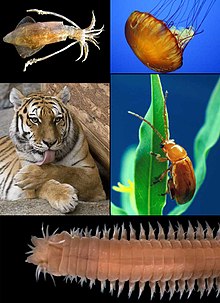Planulozoa
| Planulozoa | |
|---|---|

| |
| Diversity of planulozoans | |
| Scientific classification | |
| Kingdom: | |
| Subkingdom: | |
| (unranked): | |
| (unranked): | Planulozoa Wallberg et al., 2004
|
| Phyla | |
|
Bilateria/Triploblasts (unranked)
| |
Planulozoa is a proposed basal ParaHoxozoa clade, sometimes as sister of the Placozoa, but originally included Placozoa.[1][2] In the latter case Planulozoa may be a senior synonym to Parahoxozoa. It contains the Cnidaria (sea anemones and jellyfish) and the Bilateria (all the more complex animals including flatworms, insects and vertebrates). The Placozoa may be a sister of Cnidaria[3][4][5][6] or more conventionally of Planulozoa.[7] The clade excludes basal animals such as the Ctenophora (comb jellies),[8][9][2] and Porifera (sponges).[10][11][12]
The phylogenetic tree indicates approximately how many millions of years ago (mya) the lineages split. Here, Planulozoa is shown sans Placozoa.[13][14][15]
Planulozoa are associated with the emerge of the Zoc and ZF-NC gene domains.[16]
| Choanozoa |
| ||||||||||||||||||||||||||||||||||||||||||||||||
| 950 mya |
References
- ^ Edgecombe, G. D.; Giribet, G. (2019-01-15), “Perspectives in Animal Phylogeny and Evolution”: A decade later, University of Padova Press, ISBN 9788869381409, retrieved 2019-07-17
- ^ a b Andreas Wallberg; Mikael Thollesson; James S. Farris; Ulf Jondelius (2004). "The phylogenetic position of the comb jellies (Ctenophora) and the importance of taxonomic sampling". Cladistics. 20 (6): 558–578. doi:10.1111/j.1096-0031.2004.00041.x.
- ^ Aleshin VV, Petrov NB (2002) Molecular evidence of regression in evolution of metazoa. Zh Obshch Biol 63(3):195-208
- ^ Laumer, Christopher E; Gruber-Vodicka, Harald; Hadfield, Michael G; Pearse, Vicki B; Riesgo, Ana; Marioni, John C; Giribet, Gonzalo (2018-10-30). "Support for a clade of Placozoa and Cnidaria in genes with minimal compositional bias". eLife. 7. doi:10.7554/elife.36278. ISSN 2050-084X. PMC 6277202. PMID 30373720.
{{cite journal}}: CS1 maint: unflagged free DOI (link) - ^ Schuchert, Peter (1993-03-01). "Trichoplax adhaerens (Phylum Placozoa) has Cells that React with Antibodies Against the Neuropeptide RFamide". Acta Zoologica. 74 (2): 115–117. doi:10.1111/j.1463-6395.1993.tb01227.x.
- ^ Syed, Tareq; Schierwater, Bernd (2002-06-01). "The evolution of the placozoa: A new morphological model". Senckenbergiana Lethaea. 82 (1): 315–324. doi:10.1007/bf03043791. ISSN 0037-2110.
- ^ Eitel, Michael; Francis, Warren; Osigus, Hans-Jürgen; Krebs, Stefan; Vargas, Sergio; Blum, Helmut; Williams, Gray Argust; Schierwater, Bernd; Wörheide, Gert (2017-10-13). "A taxogenomics approach uncovers a new genus in the phylum Placozoa". bioRxiv: 202119. doi:10.1101/202119.
- ^ Andreas Hejnol; Mark Q. Martindale (2008). "Acoel development supports a simple planula-like urbilaterian". Philosophical Transactions of the Royal Society B. 363 (1496): 1493–1501. doi:10.1098/rstb.2007.2239. PMC 2614228. PMID 18192185.
{{cite journal}}: Unknown parameter|lastauthoramp=ignored (|name-list-style=suggested) (help) - ^ Jaume Baguñà; Pere Martinez; Jordi Paps; Marta Riutort (2008). "Back in time: a new systematic proposal for the Bilateria". Philosophical Transactions of the Royal Society B. 363 (1496): 1481–1491. doi:10.1098/rstb.2007.2238. PMC 2615819. PMID 18192186.
- ^ Whelan, Nathan V.; Kocot, Kevin M.; Moroz, Tatiana P.; Mukherjee, Krishanu; Williams, Peter; Paulay, Gustav; Moroz, Leonid L.; Halanych, Kenneth M. (2017-10-09). "Ctenophore relationships and their placement as the sister group to all other animals". Nature Ecology & Evolution. 1 (11): 1737–1746. doi:10.1038/s41559-017-0331-3. ISSN 2397-334X. PMC 5664179. PMID 28993654.
- ^ C. Borchiellini; M. Manuel; E. Alivon; N. Boury-Esnault; J. Vacelet; Y. Le Parco (2001). "Sponge paraphyly and the origin of Metazoa". Journal of Evolutionary Biology. 14 (1): 171–179. doi:10.1046/j.1420-9101.2001.00244.x. PMID 29280585.
- ^ Pisani, Davide; Pett, Walker; Dohrmann, Martin; Feuda, Roberto; Rota-Stabelli, Omar; Philippe, Hervé; Lartillot, Nicolas; Wörheide, Gert (2015-12-01). "Genomic data do not support comb jellies as the sister group to all other animals". Proceedings of the National Academy of Sciences. 112 (50): 15402–15407. Bibcode:2015PNAS..11215402P. doi:10.1073/pnas.1518127112. PMC 4687580. PMID 26621703.
- ^ Peterson, Kevin J.; Cotton, James A.; Gehling, James G.; Pisani, Davide (27 April 2008). "The Ediacaran emergence of bilaterians: congruence between the genetic and the geological fossil records". Philosophical Transactions of the Royal Society of London B: Biological Sciences. 363 (1496): 1435–1443. doi:10.1098/rstb.2007.2233. PMC 2614224. PMID 18192191.
- ^ Parfrey, Laura Wegener; Lahr, Daniel J. G.; Knoll, Andrew H.; Katz, Laura A. (16 August 2011). "Estimating the timing of early eukaryotic diversification with multigene molecular clocks". Proceedings of the National Academy of Sciences. 108 (33): 13624–13629. Bibcode:2011PNAS..10813624P. doi:10.1073/pnas.1110633108. PMC 3158185. PMID 21810989.
- ^ "Raising the Standard in Fossil Calibration". Fossil Calibration Database. Retrieved 3 March 2018.
- ^ Layden, Michael J. (2018), "Cnidarian Zic Genes", Zic family, Advances in Experimental Medicine and Biology, vol. 1046, Springer, Singapore, pp. 27–39, doi:10.1007/978-981-10-7311-3_2, ISBN 9789811073106, PMID 29442315



